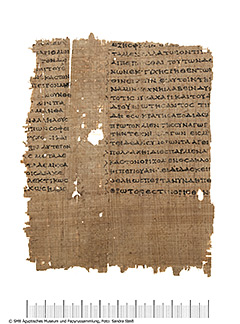BKT II, S. 52–53 (P. 9809 R)
What does a good speech have to do with lust and love? This philosophical treatise seems to deal with some principles of how to make good speeches. For this purpose, quotations from two dialogues by the Greek philosopher Plato are used, in which these principles are explained using the topics lust and love as examples.
This papyrus was found on 28th February 1902 during the excavation of Otto Rubensohn in Batn el-Harit, the ancient Theadelpheia, and shortly thereafter came to the Berlin Papyrus Collection. The site is located in the Fayum, a large oasis southwest of Cairo, where many ancient papyri were found. On the papyrus there are remains of two columns of a text, of which the upper part is missing. Of the 18 lines of the first column there are still line-endings with about one third of the text. The preserved lines of the second column are almost complete. The text can be dated to the 2nd century AD because of the hand-writing and the letter forms. It is written in Greek like most papyri from this time.
The text is a philosophical treatise with long quotations from the writings of the Greek philosopher Plato. These quotations are clearly marked by a diple (double hook) in front of the lines, as can be seen in front of most lines of the second column. In addition, before and after the quotation at the beginning of the line, a short horizontal line has been placed above or below the line. This line is called paragraphos. The first column, whose preserved part consists entirely of a citation, probably had the same markings. But the beginning of the line is missing.
The first column quotes a passage from the Platonic dialogue „Philebus“. In this dialogue Plato’s teacher Socrates discusses the ethical evaluation of lust with the young Athenians Philebus and Protarchus. While Philebus and Protarchus consider lust as the highest value and equate it with the good, Socrates gives priority to reason and understanding. In the quoted part of the dialogue they discuss the relationship between unity and multiplicity, since on the one hand the pleasures are also manifold and diverse, but on the other hand they form a unity and are summarized under a common term. Socrates emphasises in the quote that the area between the unity of the One and the boundlessness of the Many must be considered carefully in order to explore reality properly.
The second column quotes a passage from the Platonic dialogue „Phaedrus“. In this dialogue, Socrates and his friend Phaedrus discuss the art of speech in the relationship between rhetorical persuasion and philosophical truth-finding. A speech by the Athenian speaker Lysias about love and a counter-speech by Socrates on the same topic serve as examples. The quoted part of the dialogue deals with two principles contained in both speeches: on the one hand, to combine often scattered ideas into one idea in order to make clear the subject of discussion; on the other hand, to break down an idea into individual concepts.
About the purpose and the contents of the treatise one can only make some assumptions due to the few preserved remains. What both preserved quotations have in common is the idea of a dialectical analysis of an object – lust in „Philebus“, love in „Phaedrus“ – in order to recognize and convey the truth. Who wrote this papyrus text is unknown. It is possible that it was used in a school context.
However, some time later – 100 years at the most – people apparently no longer had any interest in this text and used the back of the valuable papyrus-material for a letter. For this purpose the preserved sheet was cut out of a roll and reused.



